http://www.creative-sz.com/Easy-ECG-Monitor/Easy-ECG-Monitor-PC-80C.html
or
http://www.creative-sz.com/Tele-healthcare-Network/PC-80B-Bluetooth-Easy-ECG-Monitor.html
This is the latest version of the PC-80, one of three different handheld ECG devices
that I originally reviewed in 2006. At the time, I commented: "It would be nice if one could
somehow combine the best of all three [different handheld devices] into a single unit, for
example, something like a PC-80 with its size, lighted display, and rocker panel for selecting
among menus, but with longer time before auto-shutoff and all of the better features and
superior software of the IC." This latest version essentially accomplishes just that, plus
having a large, well-lighted (so it works good in the dark) color display, options for different
lengths of recording including continuous (and can even be used like a Holter monitor!),
new and added features in the software, plus options for USB cable, Bluetooth wireless,
or ZigBee for uploading records to the computer.
The PC-80 and its software have gone through many revisions, updates, and improvements,
to the point that it is one of the state-of-the-art handheld ECG devices (IF you get the
latest version and software [see note at end of the section] and know enough about ECGs
to be able to use it).
The latest software is very functional and user friendly/intuitive (once you figure out
the correct version to use!, see note at end). The software is sophisticated with many features,
including an easy built-in caliper for measuring parts of waveforms. The device has both
finger contacts and lead-wire cables.
The PC-80B Color and its software is stand-alone, user-managed, up to the user to communicate
with the physician (or be a physician), and the user needs to be somewhat ECG savvy.
Photo of materials received with purchase: shipping package, plastic
box with padding, User Manual, Quick Guide, Practical Use guide (not shown in photo), the
device with a leather carrying case, software disk, lead-wire cables, and upload cable (for
the USB option).
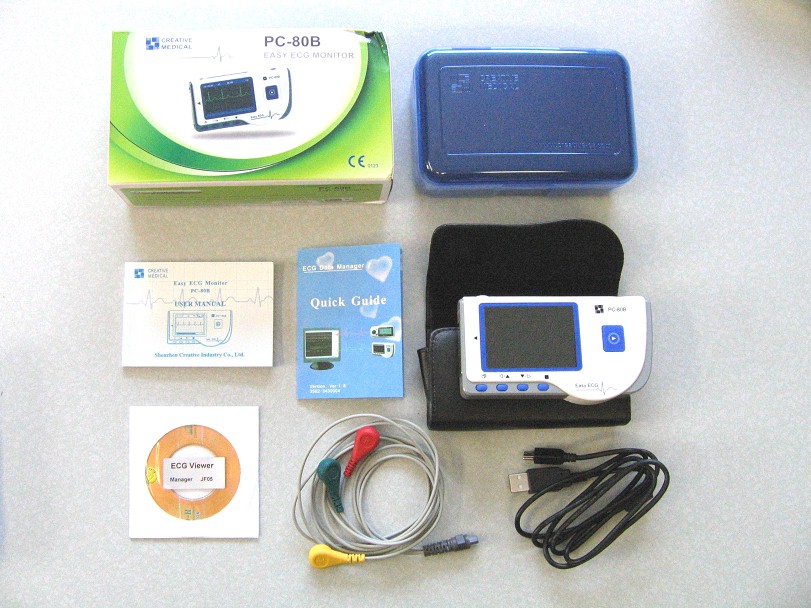
Photo of device startup menu, ready to begin recording with a
push of the button.
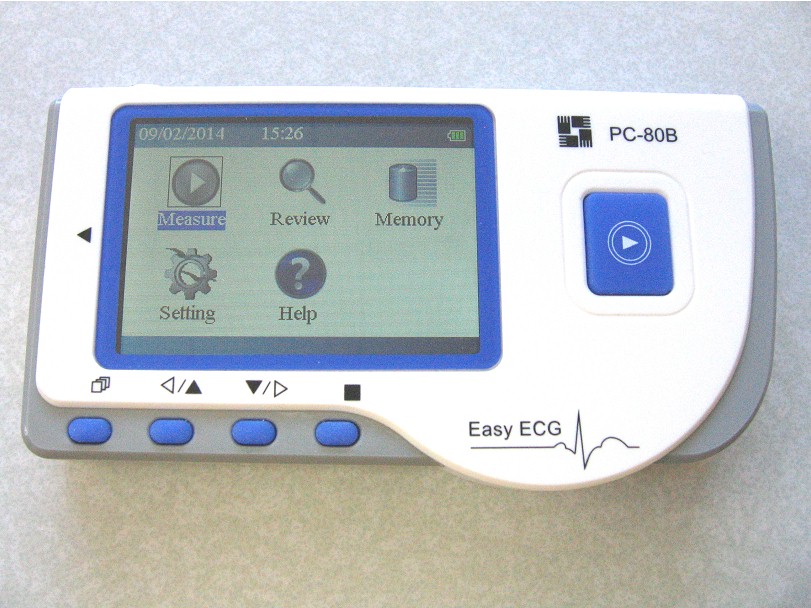
Recording using the finger/hand contacts (recordings can also be made
using the lead-wire cable and adhesive skin electrodes). Screen displays, incidentally,
are brighter and better than they appear in these pictures. The display surfaces are reflective
and had to be tipped for photos to avoid distracting reflections.
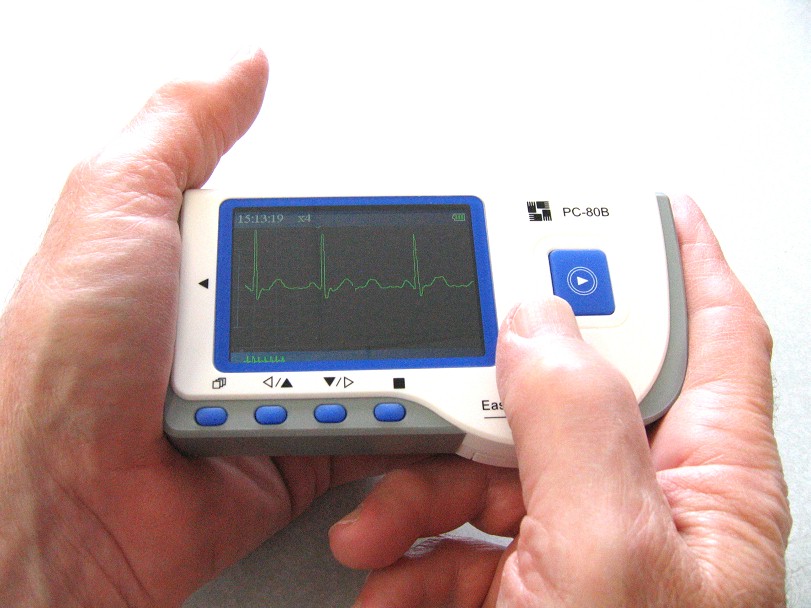
View of a stored ECG record on the device display (including a scale
at the bottom indicating the segment being displayed). Display includes background grid
markings.
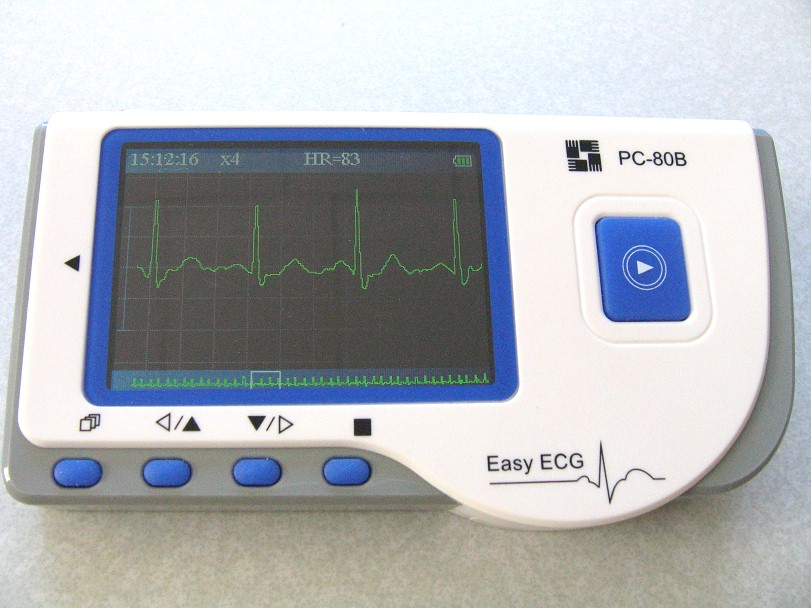
View of section of a list of records (left panel), a recording (normal
sinus rhythm, NSR, plus a few PVCs), and menus etc. on the computer screen while using the
software. An onscreen caliper allows one to measure various parts of the waveform of a selected
beat, as shown, by moving the red and black markers. By right-clicking the box of the selected
beat, one can get a zoomed, pop-up box view of that beat, as shown. There are several options
and views available (see examples of others below). The software has much utility, is very
flexible, and is very intuitive and easy to use with features normally seen only in much
more expensive PC-based 12-lead and Holter systems.
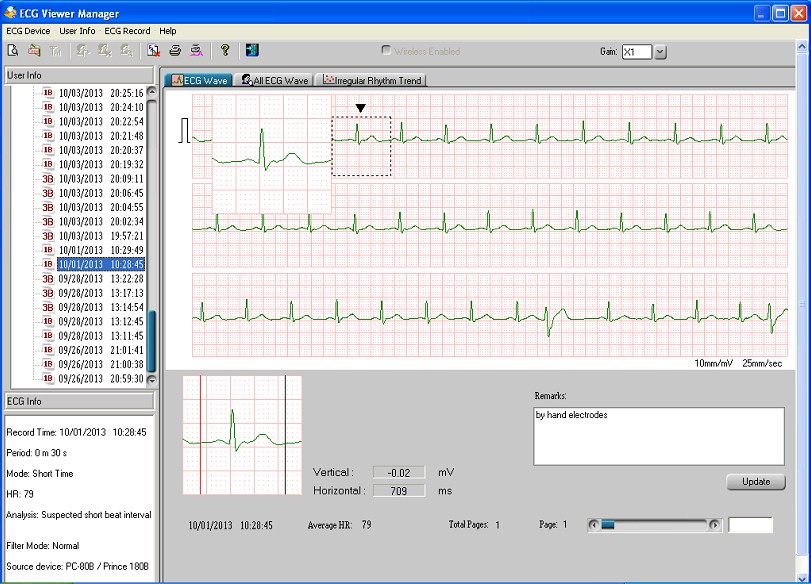
Here is a section from a long recording of an episode of atrial fibrillation
(afib) plus it includes a PVC (second line, obvious). The sliding page bar at the bottom
right allows one to scroll through the whole record. Also see the next figures.
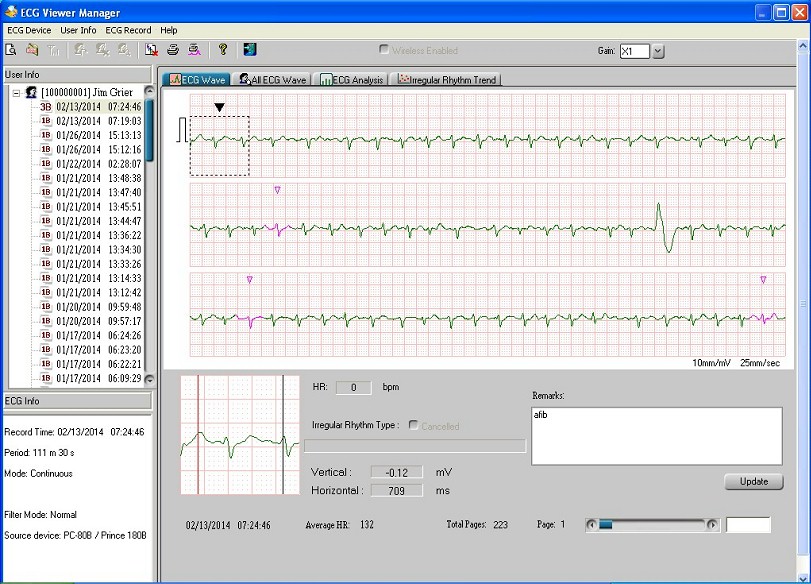
With the "All ECG Wave" tab clicked, one gets the full disclosure of
a recording, in this case, a long recording of an afib episode.
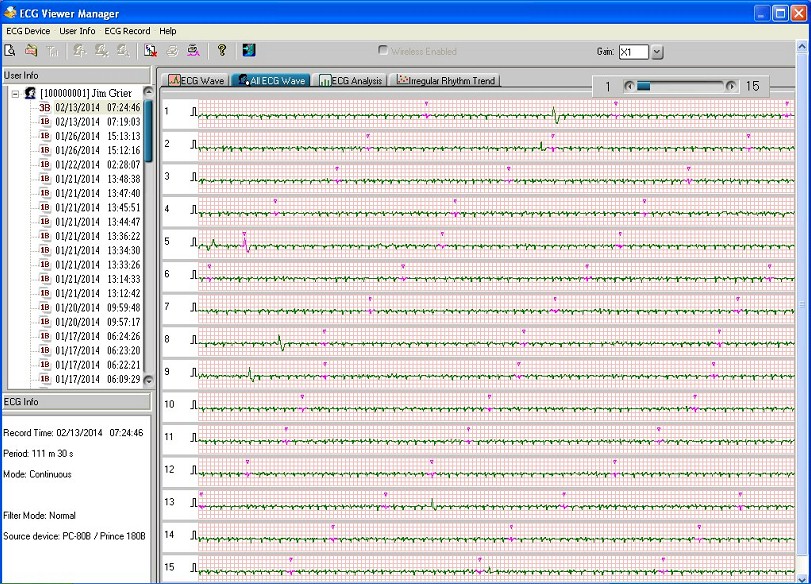
Continuing with the afib recording shown above, the afib converted
on its own during the course of the recording. By using the "ECG Analysis" tab, which shows
heart rate (HR) trend, one can easily see the point of conversion toward the end of the
recording when the rate which has been fluctuating around 130 drops to around 100.
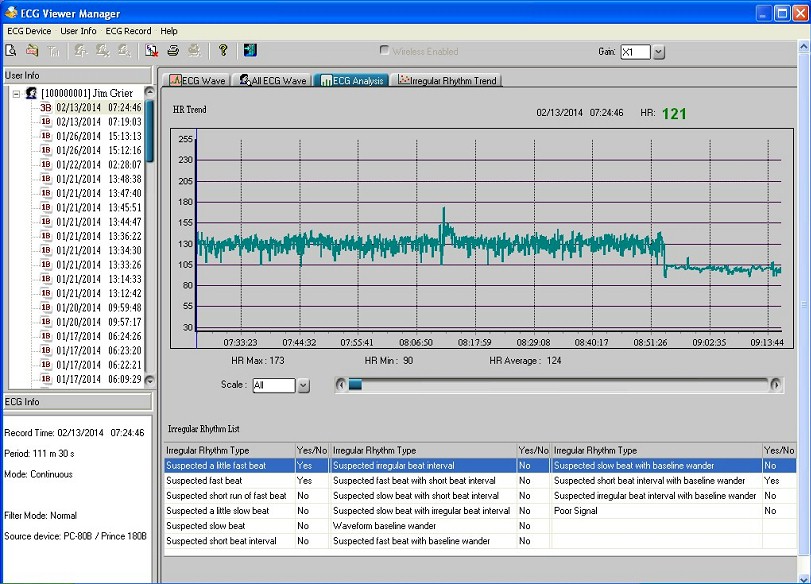
And the afib with its conversion is also seen when plotted in another
way by clicking on the "Irregular Rhythm Trend" tab, as seen here.
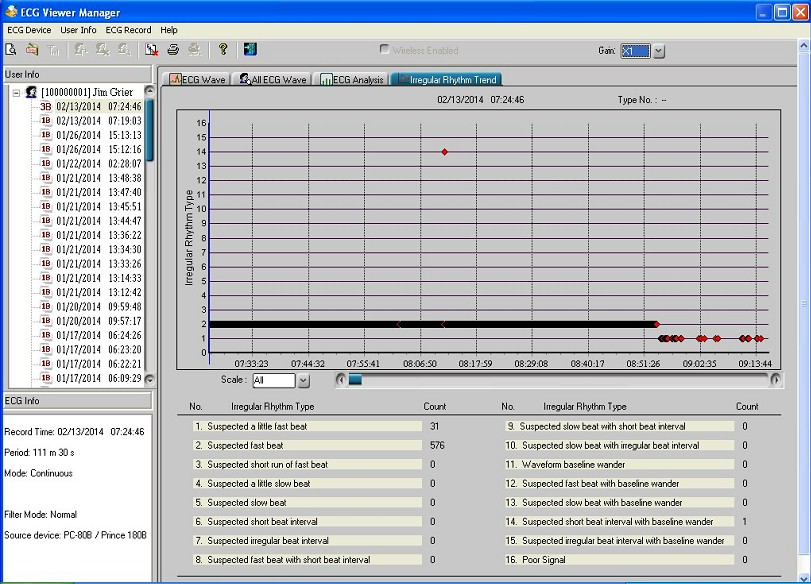
Printed example of a recording (NSR plus some PVCs).
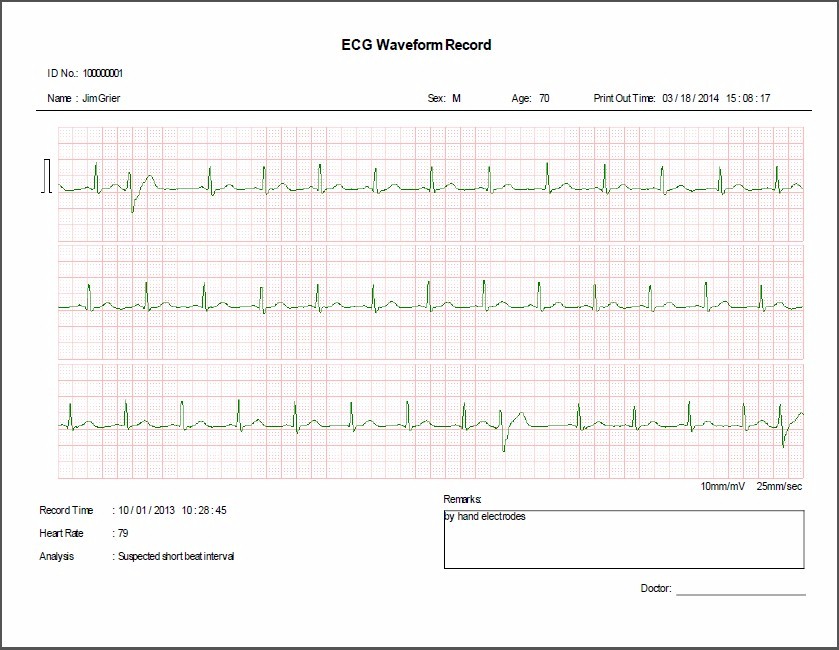
Device characteristics
- Physical: 5 x 2 3/4 x 3/4 in (126 x 68 x 20 mm), 4.1 oz
(118 g)
- Display screen: color, 2 1/4 x 1 1/2 in (57 x 39 mm)
- Length(s) of recordings: 30 sec for "quick measurement"
with the finger contact electrodes or, if using the lead-wires, "continuous", that is,
until whenever stopped
- Time to auto-shutdown: 35 sec when there is no operation
- Additional cable-wires for adhesive skin electrode recording:
yes
- Internal or memory-card storage capacity: 1200 30-second
records or up to 10 hr continuous recording
- Ability to add comments to recording files: yes
- Device menus and ease of use: clear/intuitive and very user
friendly
- Software or app menus and ease of use: numerous features
and menus, all clear/intuitive and very user friendly
- Printouts: can be sent to selected printer.
- Cost: around $300
- Advanced recordings such as sequential 12-lead: yes, but
see note in the next section below regarding the color/letter-coded connections on the
lead wires (more on this to be posted later, if and when I get around to it)
Other aspects and comments: State-of-the-art 1-lead (with the possibility of doing
sequential other leads), handheld ECG device with very sophisticated but intuitive and easy-to-use
software. Both the device and software have gone through numerous revisions and improvements
since the original PC-80.
Notes and cautions: This device seems to be available in different versions under a
confusing array of similar names related to "PC-80B" (and "Prince 180B", which is similar
but not identical ... it is generally sold for less, does not usually include the
cable/lead-wires, and does not do continuous recording, only 30 second recordings
[even if one gets the cable/lead-wires and uses that for electrode input]; see next device
described, below)! The specific one that I reviewed here is referred to by the originating
company (Creative Medical, Shenzhen, China) as both "PC-80B Color" and "PC-80B Color Bluetooth"
although not all of the units called "Bluetooth" have the wireless Bluetooth connection;
some may have and connect to a computer by USB or ZigBee options! There are also [earlier?]
versions of PC-80B (and Prince 180B) that have a SD memory card slot but do not have all
of the features (as well as I can determine from the descriptions) of the one with the color
display and wireless option. This latest one should at least be called PC-80C
(which the company also uses in one of the web links for it and some sellers refer to it
as PC-80B-C).
The device appears to have evolved and divided into more options and versions faster
than its name has been able to keep up! Thus, I urge care and caution that an interested
buyer be very careful when purchasing a unit to make sure you carefully specify or shop
for and get the specific one you want. The one I tested was "PC-80B Color" (with emphasis
on "Color" in the name) with USB connection, not wireless or ZigBee.
The software disk that comes with the latest version may also have earlier versions of the
software included on the disk with little indication as to which one should be used! I had
to use the "wireless" version of the software even though my specific unit was USB, not
wireless! And the user manuals seem to be a mixture of versions. The confusion over software
version may have led to poor reviews of the device by other persons on other web sites.
Hopefully the company will clean up the current mess. (I understand they are working on
it, based on my reports to them, and I'll eventually be able to delete these notes and cautions.)
In the meantime, it remains a mess and you need to be careful so you get exactly the version
you want when purchasing and then select the correct software version on the disk when installing.
Color/letter coding of the lead-wire connections: When trying to run (sequential)
12-lead combinations with the lead wires, I got confusing results using the 3 lead-wire
connections following the color/letter codes and company recommendations. I also have gotten
several inquiries about this issue from persons who bought the PC-80B Color device. As currently
supplied, the lead-wires appear to be incorrectly (or at least confusingly) colored/marked.
Here's what worked best for me regarding the lead-wire connections:
* red/"R": okay as indicated -- right side or negative electrode
* green/"F": use as the left side or positive electrode
* yellow/"L": use as the neutral or ground (right leg or RL)
(I marked mine with a permanent marker to remind me.) When used that way, they appear to
work in the various positions as with sequential 12-lead electrodes. I plan to do more testing
along these lines and hope to eventually post the results here.
Sources: See the links to the company at the start of this section.
The PC-80B color might become available from
Favoriteplus.com after their
stock of the original PC-80s are sold out. It is also available from numerous other sources
including several US suppliers and is often listed on eBay – do a web or eBay search for
it. (But, again, make sure you request and get the version you want, and install the "wireless"
version of the software even if you don't get an actual wireless unit ... see earlier comments.)









